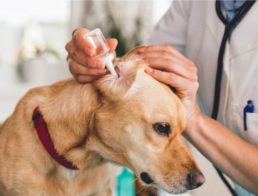Question: How can I ease the pain of my dog’s ear infection?
We just brought a foster dog home. He has terrible ear infections, the left one is worse.
He is taking prednisone, neomycin polymyxin sulfate with hydrocortisone, ciprofloxacin.
He is in a lot of pain.
I was wondering if I could put ice on his ears to cool them down. They are really hot. Are there any pain medications I could ask for that would not interfere with his meds? His name is Hugo and he is about 3 to 6 years old.
–Diana
Answer:
Dear Diana,
Painful, inflamed ears can be uncomfortable for dogs. Dogs with inflamed ears (otitis) will shake their heads, scratch at their ears, rub their ears on furniture, and may become frantic trying to relieve the itch and pain.
The medications prescribed for your foster dog should work within a day or two to calm down the inflammation. Prednisone and hydrocortisone are both corticosteroids.
Prednisone is an oral medication that calms inflammation in the entire body, including the ears. The reason this is helpful is that the most common cause of otitis in dogs is allergies. Prednisone decreases the immune system’s abnormal response to pollens.
The hydrocortisone in the ear drops acts locally to decrease the redness and pain in the ears. It also helps decrease the excessive production of wax that often occurs with otitis.
Safe Pain Medication
If your dog doesn’t feel better within a couple of days, contact your veterinarian. There are several different prescription pain medications that can make him more comfortable. Your vet will know which medications are safe to give with the ones Hugo is already taking.
Avoid giving over-the-counter non-steroidal anti-inflammatory drugs (NSAIDs) while he’s taking prednisone. Do not give aspirin, ibuprofen, or naproxen. Dogs are sensitive to NSAID effects and can have severe digestive tract side effects when NSAIDs are given with prednisone.
There are a few other things you can try at home while waiting for the corticosteroids to kick in…
Cool Water Compresses
Use a washcloth or a hand towel dipped in cool water then wrung out. Hold the cloth on the areas that feel hot. Hold the cloth over the area for five to ten minutes, then refresh it with cool water.
Cool compresses are gentler than ice compresses which can damage tissue if left on too long. If your dog doesn’t accept the compress don’t push the issue.
Ear Wrap
If your dog is shaking his head a lot, it may be helpful to keep the ears held close to his head. This reduces the irritation that can result from violent flapping of the ears. Try the Happy Hoodie Ear Wrap. This soft “hood” can also have a calming effect on anxious dogs. It may be just the thing to help.
Keep the Ears Up
On the other hand, if your dog has heavy, floppy ears like a basset hound, it can be helpful to keep the ears held up. Opening the ear canal will allow excessive moisture to evaporate.
You can do this by holding his ear flaps in the up position while watching television or reading. If your dog allows it, direct a gently blowing fan toward the opening of the ear to help evaporation.
Follow your vet’s directions and make sure to keep follow-up appointments. Otitis in dogs can become a chronic problem if not treated appropriately. If you can’t get this episode cleared up or if the problem recurs within a year, ask your vet about more definitive ways to prevent future flare-ups.
There are good allergy medications available that have fewer side effects than prednisone. Some dogs also benefit from a change in diet. Your veterinarian will be able to help you come up with a game plan to make sure your dog’s ears stay healthy (learn how to properly clean your dog’s ears).
Regards,
TB Thompson DVM
Disclaimer: Your use of the Ask The Vet feature is subject to the Ask The Vet Terms of Use.
Featured Image Credit: Yekatseryna Netuk Shutterstock
























